Blockchain Application Development: Ultimate Guide For Businesses
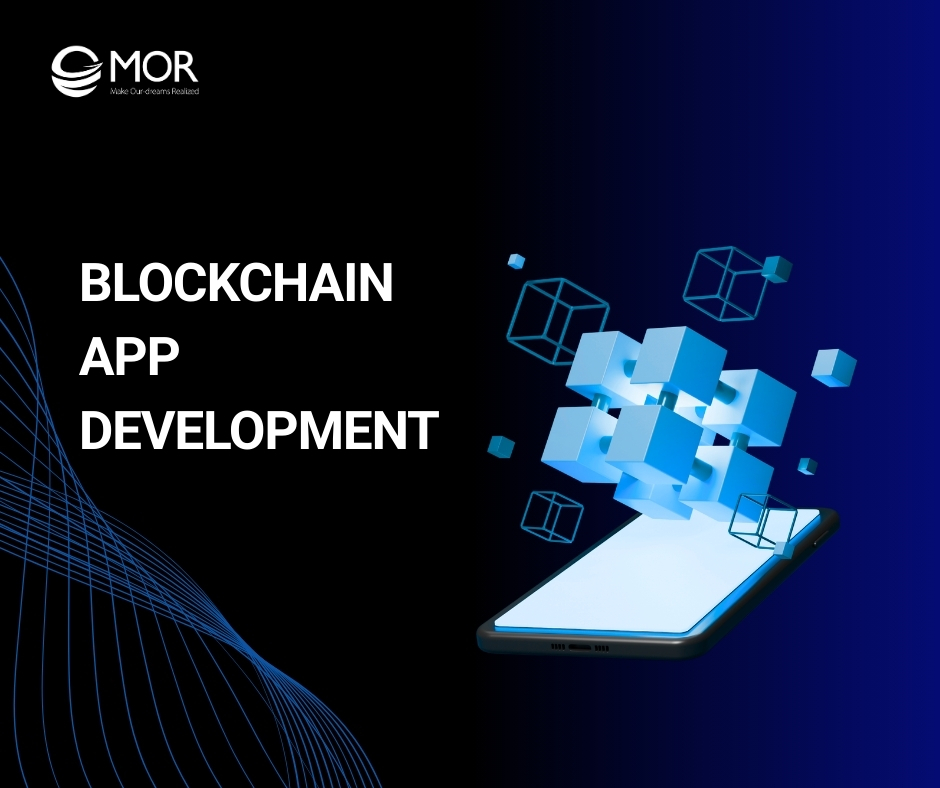
More companies are turning to blockchain application development to boost security, transparency, and efficiency. Still, picking the right blockchain app development company and managing costs can feel overwhelming. This MOR Software’s guide breaks it down, helping you understand the platforms, benefits, and steps to build a successful blockchain application.
What Is Blockchain App Development?
Blockchain app development is the practice of designing and deploying applications that operate on decentralized blockchain networks instead of relying on traditional centralized servers. These applications, commonly known as dApps, are gaining traction in diverse industries such as finance, blockchain in healthcare, logistics, and government services.
Through peer-to-peer infrastructure, blockchain apps eliminate the reliance on middlemen, giving users higher transparency, stronger security, and direct control over their data. Well-known examples include DeFi platforms, cryptocurrency wallet development, and solutions for digital asset management or supply chain monitoring.
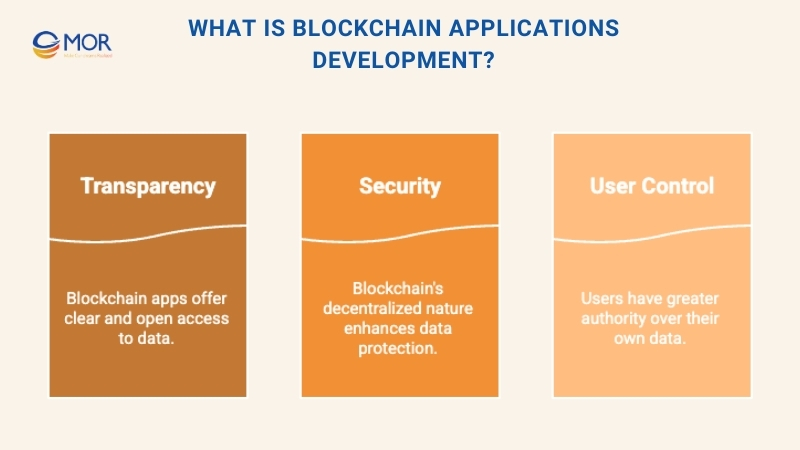
What makes blockchain powerful is its immutable way of recording information. Once data is stored on the chain, it cannot be altered or deleted. This makes it a trusted option for handling transaction histories, property records, medical information, and ownership credentials.
The industry shows no signs of slowing down. According to Precedence Research, the blockchain market is projected to surge from $41.15 billion in 2025 to more than $1.87 trillion by 2034, achieving a remarkable 52.9% compound annual growth rate.
How Does Blockchain App Development Work?
At its core, blockchain app development merges business logic with decentralized technology to deliver secure and transparent applications. Unlike traditional apps that rely on a central server, these run on distributed networks where transactions are validated across multiple nodes and recorded permanently.
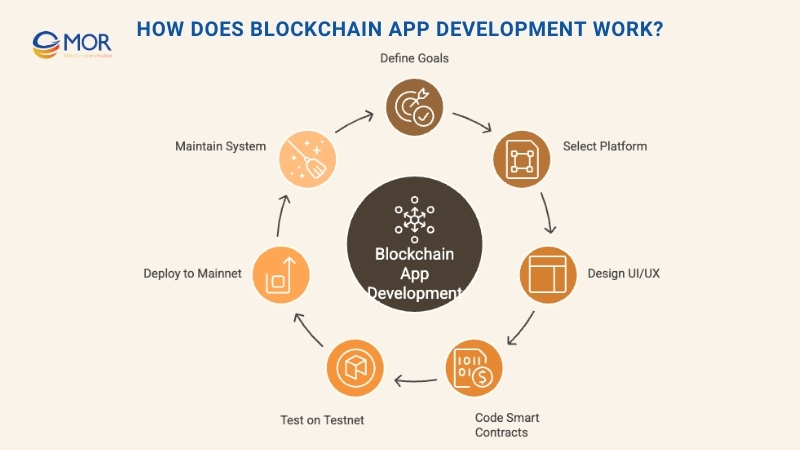
The workflow usually follows a structured approach:
- Define the goal: Identify the business problem and decide what the blockchain app should achieve.
- Pick a platform: Choose a blockchain platform like Ethereum, Hyperledger, or Quorum based on scalability, security, and cost.
- Design the experience: Create a user-friendly interface (UI/UX) to simplify blockchain interactions for end users.
- Code smart contracts: Develop self-executing agreements that automate tasks such as payments or approvals.
- Test on a blockchain testnet: Simulate transactions, debug, and validate security before moving to production.
- Deploy to the main network: Launch the app for real-world use, ensuring scalability and compliance are in place.
- Maintain and update: Continuously monitor performance, fix issues, and upgrade features over time.
The outcome is an app where users own their data, enjoy faster transactions, and gain trust in systems that don’t depend on a single authority.
Types Of Blockchain Systems
Businesses can adopt different blockchain systems based on their industry needs, compliance rules, or desired level of user access. Each model delivers a unique balance of control, transparency, and decentralization.
Before starting any blockchain app development, it’s useful to understand the four primary categories of distributed ledgers and where they are most effective.
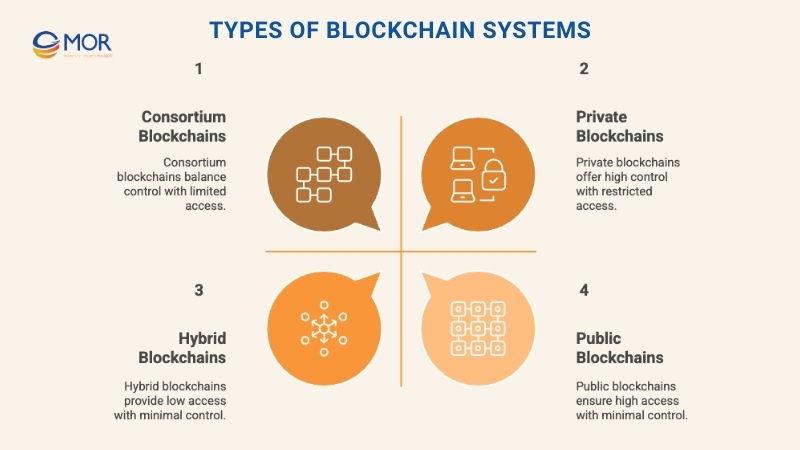
Public (Permissionless) Blockchains
Public blockchains are open networks where anyone can read, write, and participate without restrictions. They run on full decentralization, making every transaction transparent and nearly impossible to modify without agreement from the entire community. This structure is trusted for its immutability and high security.
Common Use Cases:
- Well-known platforms like Bitcoin and Ethereum are built on public chains.
- Decentralized finance (DeFi) applications and NFT marketplaces rely on public networks to support open trading, lending, and asset ownership.
Private (Permissioned) Blockchains
Private blockchains, also called permissioned blockchains, are managed by one company or a small group of trusted partners. Only approved members and blockchain app developers can access, validate, or record transactions.
This setup is a strong fit for enterprises that need to protect confidential data and maintain tighter control over who participates in the network.
Common Use Cases:
- Internal supply chain management
- Corporate recordkeeping systems
- Secure handling of healthcare data
Hybrid Blockchain Models
Hybrid blockchains combine elements of public and private systems. They let some information remain transparent while keeping sensitive data available only to authorized users. This design allows businesses to build applications that balance openness with confidentiality.
Common Use Cases:
- Enterprise AI platforms that meet privacy regulations but still demonstrate operational transparency
- Financial services that hide customer identities while keeping transaction histories verifiable
Consortium Blockchains
Consortium blockchains operate under a semi-decentralized model, where the consensus process is handled by a selected group of organizations or institutions. This shared control is valuable in industries that rely on collaboration and mutual trust between multiple parties.
Common Use Cases:
- Joint banking and insurance projects
- Global payment networks
- Governance systems tailored for specific industries
Key Benefits Of Blockchain Applications Development
Even in times of economic volatility, the blockchain industry keeps proving its resilience and ability to adapt. Businesses across finance, healthcare, logistics, and identity management are turning to blockchain app development to solve practical challenges with modern, trusted infrastructure.
At its core, blockchain technology is designed for reliability, speed, and trustworthiness. That’s why organizations and blockchain app development companies are investing in it to future-proof their operations.
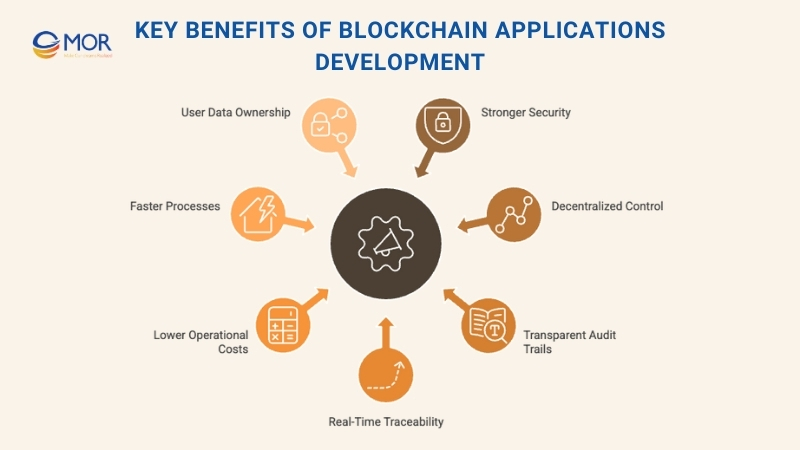
Stronger Security With Cryptography
One of the greatest strengths of blockchain lies in its tamper-proof design. Data stored on the chain is secured with advanced cryptography, making unauthorized changes nearly impossible.
Each block carries a unique hash and links back to the one before it. Any attempt to alter a single record would require modifying the entire chain across all connected nodes, which is not feasible.
This level of protection makes blockchain ideal for industries that handle sensitive data, whether it’s patient health information, identity verification, or legally binding digital contracts. Smart contracts add another layer of trust by executing transactions automatically without relying on intermediaries.
Decentralized Control And Reliability
Traditional apps run on centralized servers, leaving them vulnerable to single points of failure. In contrast, blockchain app development uses decentralized networks where every participant maintains a copy of the ledger and validates transactions.
This distributed design makes the system far more reliable. Even if several nodes go offline, the app continues to function smoothly. With no central authority to censor or manipulate records, it becomes especially valuable for finance platforms, digital content sharing, and governance systems.
Transparent Audit Trails
Every action on a blockchain is permanently logged in a shared ledger visible to all approved participants. By adopting custom blockchain app development, businesses gain a system where transactions are always traceable, verifiable, and transparent in real time.
Industries like supply chain management, logistics, and banking benefit from this openness. It reduces fraud, builds accountability, and helps organizations stay compliant. Products or assets can be tracked from their origin to the end user without depending on intermediaries or manual verification.
Real-Time Traceability
Conventional payment networks often take hours or even days to settle, especially for international transactions. Blockchain systems work around the clock, validating transactions almost instantly depending on the chain’s protocol.
By cutting out delays from intermediaries and manual checks, blockchain mobile app development enables faster execution that benefits e-commerce, digital payments, and platforms requiring real-time data exchange.
Lower Operational Costs
One of the strongest advantages of dapp development services is cost efficiency. With peer-to-peer transactions and automated smart contracts, businesses no longer rely on third parties like banks or clearinghouses to complete processes.
This shift is particularly valuable in lending, remittances, and cross-border payments where legacy systems are slow and expensive. Organizations can cut fees, reduce administrative burdens, and simplify infrastructure by adopting blockchain-driven solutions.
Faster Processes Through Automation
Smart contracts eliminate intermediaries and manual approvals, allowing transactions and workflows to execute automatically. In supply chain logistics, for instance, a contract can release payment as soon as IoT sensors confirm delivery.
This automation not only reduces human error but also speeds up turnaround times, ensuring reliable performance across even the most complex operations.
User Data Ownership And Privacy
In traditional applications, third parties often control and profit from user data. With blockchain software, ownership shifts back to the individual, giving them authority over their digital identity, assets, and information.
A blockchain-based identity app, for example, lets users decide exactly what data to share and with whom. This level of autonomy builds trust and aligns with growing demands for stronger data privacy.
>>> READ MORE: How Does Enterprise AI Software Work to Automate Decisions?
Popular Platforms For Blockchain App Development
Blockchain app development platforms supply the infrastructure and toolsets required to design decentralized applications. They include features such as consensus mechanisms, smart contract execution, and developer frameworks.
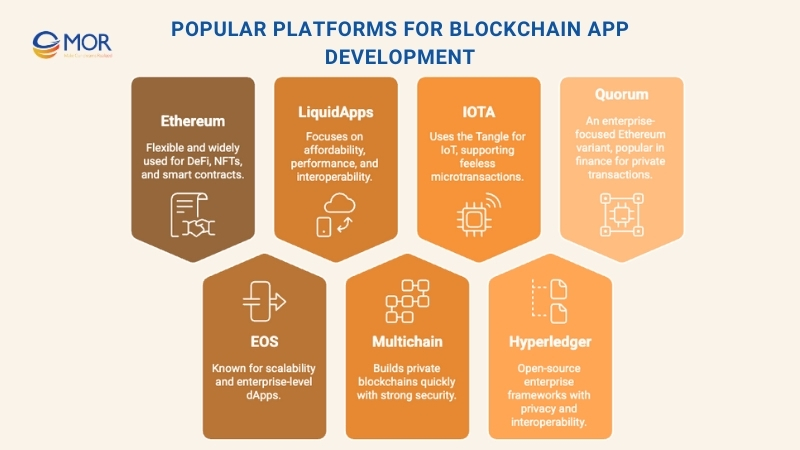
We’ve covered some of the most widely used platforms powering blockchain innovation today:
Ethereum
Ethereum is one of the earliest and most influential platforms for decentralized apps and smart contract. Its flexible environment gives developers freedom to build everything from DeFi protocols to NFT marketplaces, making it a cornerstone of the blockchain ecosystem.
EOS
EOS is recognized for its scalability and speed in supporting programming blockchain applications. With its distinctive governance model and adaptable resource management, EOS is a strong choice for enterprises aiming to deploy large-scale decentralized solutions.
LiquidApps
LiquidApps is designed to make blockchain for development more scalable and affordable. Its DAPP Network improves resource efficiency, helping decentralized apps run with better performance and accessibility. The platform also emphasizes interoperability and provides intuitive tools that simplify the developer experience.
Multichain
Multichain is a flexible platform built for creating private blockchains with speed and simplicity. It enables rapid deployment across industries like finance and supply chain while allowing organizations to customize chain parameters. With strong data security features, Multichain supports reliable enterprise-grade applications.
IOTA
IOTA takes a different approach by using a non-blockchain structure called the Tangle, built for Internet of Things applications. It supports secure data transfers and feeless microtransactions, making it suitable for industries that require high scalability and massive volumes of small payments.
Hyperledger
Hyperledger is an open-source initiative that delivers a collection of frameworks and tools for enterprise blockchain projects. Known for its focus on privacy, interoperability, and performance, it’s a preferred choice for industries that demand secure, industry-specific solutions.
Quorum
Quorum, developed as an enterprise-focused version of Ethereum, enhances privacy and performance for private transactions. It’s widely used in financial services where confidentiality and speed are essential.
Supporting both public and private deployments, Quorum gives organizations a flexible and secure environment for smart contract development.
Selecting the right platform is a key step in any project. Each option provides distinct benefits, and aligning those with your goals ensures successful blockchain deployment.
Blockchain App Development Use Cases By Industry
Blockchain app development services are no longer experimental, they are driving practical solutions across finance, healthcare, logistics, and even government sectors. Organizations use them to cut inefficiencies, secure sensitive records, and automate manual-heavy operations.
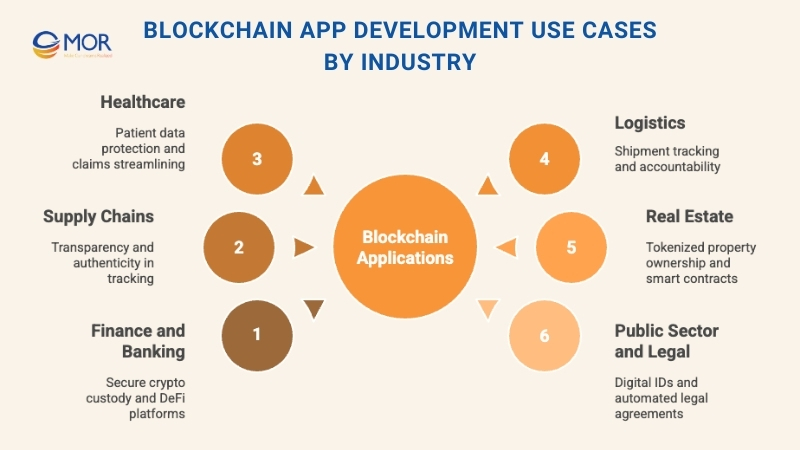
Finance And Banking: DeFi And Payments
Finance has been the leading sector in blockchain adoption, making it one of the strongest drivers of fintech innovation. Global fintech player Revolut has embedded blockchain into its digital banking systems, enabling secure crypto custody and instant asset transfers.
European banking giant Société Générale has also used Ethereum to issue tokenized bonds, simplifying settlement workflows and reducing delays.
At the same time, MakerDAO continues to expand decentralized lending and borrowing through its popular smart contract platforms, proving how blockchain can reshape modern banking and payment ecosystems.
Supply Chains: Tracking And Authenticity
Blockchain is transforming supply chain operations with unmatched transparency and traceability. Retail giant Walmart leverages IBM Food Trust, a blockchain-powered system adopted by many global food suppliers, to monitor product journeys and cut spoilage risks.
In the luxury goods sector, De Beers turned to blockchain app development companies to build Tracr, a custom platform that confirms the authenticity and ethical sourcing of diamonds, protecting brand reputation and consumer trust.
Healthcare: Patient Data And Sharing Systems
Healthcare providers are adopting blockchain to protect sensitive medical information and improve collaboration. Estonian firm Guardtime developed a national solution that secures the integrity of patient records for the country’s health service.
Meanwhile, Change Healthcare, now under UnitedHealth Group, uses blockchain to simplify claims processing, helping reduce administrative costs and prevent common billing errors.
Logistics: Shipment And Tracking Solutions
Global logistics leaders are adopting blockchain to bring accountability and reliability into their operations. DHL piloted a serialization system built on blockchain to track pharmaceuticals, helping reduce counterfeit drugs in the supply chain.
FedEx has also teamed up with a blockchain app development company to use blockchain for transparent shipment records, improving dispute resolution and customer trust.
Real Estate: Tokenized Properties And Smart Contracts
Recent surveys reveal that over 50% of retail investors are eager to invest in tokenized assets, and real estate is quickly adapting to this demand. Blockchain is reshaping the way properties are bought, sold, and managed by enabling tokenization and automating agreements through smart contracts.
Propy, a U.S.-based platform, has already completed fully digital, blockchain-recorded real estate transactions in states like Florida and California. Similarly, Mattereum, a UK startup, enables tokenized ownership of physical assets, backed by legally enforceable smart contracts that cover properties and high-value collectibles.
Public Sector And Legal: Identity And Contract Automation
Governments worldwide are exploring blockchain to strengthen digital infrastructure and public trust. In Zug, Switzerland, often called the "Crypto Valley," residents can use blockchain-based digital IDs for e-voting and accessing municipal services.
In the legal industry, projects like OpenLaw leverage Ethereum to create smart legal contracts. These agreements execute automatically on the blockchain, reducing delays, cutting paperwork, and minimizing the risk of disputes.
Blockchain App Development Process
The blockchain field is progressing quickly, with new improvements in security, usability, and scalability appearing almost every day. Turning an idea into a real-world application requires a clear roadmap that balances innovation with practicality.

Below are the core stages that guide any blockchain app development project from concept to launch.
Market Research And Analysis
Every successful application starts with understanding the market. Smart contract developers need to study user expectations, industry trends, and gaps where blockchain can add real value. This ensures the solution is not just technically sound but also commercially relevant.
Competitive analysis is also key, identifying strengths and weaknesses in existing apps helps shape a stronger product. At the same time, reviewing regulatory rules around blockchain use is critical, especially in industries like finance, healthcare, and supply chain.
Engaging with developer communities and industry groups gives valuable feedback and keeps projects aligned with real-world needs. By blending technical expertise with business awareness, blockchain app development companies create applications ready to succeed in a fast-changing digital economy.
Defining Clear Goals
Setting clear goals is one of the most important steps in the blockchain app development process. The objectives shape the project’s direction, determine its scope, and clarify the value it will deliver.
These goals might include improving transaction security, increasing transparency in supply chain management, or creating decentralized FinTech services. What matters most is identifying the core problem the application is meant to solve so that all development efforts remain aligned.
A well-defined goal acts as a benchmark for progress and helps the team establish practical milestones. Whether the aim is reducing costs, building a user-friendly interface, or ensuring compliance, objectives should follow the SMART principle, specific, measurable, attainable, relevant, and timely.
Clear targets guarantee the final solution provides real, measurable benefits to its users.
Selecting The Right Platform
Choosing the right platform is a critical step in any blockchain app development project. Each option comes with unique features, from smart contract capabilities to consensus models and transaction speeds.
Scalability, security, and community support are key factors to weigh. Platforms like Ethereum, for example, are popular because of their large developer ecosystems and extensive resources.
The chosen platform should also align with the project’s goals, whether that means processing large transaction volumes, integrating with existing enterprise systems, or enabling specific customizations.
Transaction fees, often called gas costs, also play a role in long-term sustainability. By carefully evaluating these aspects, organizations set a strong foundation for building an application that performs reliably and scales with user demand.
Brainstorming And Concept Development
The brainstorming stage is where ideas start to turn into actionable concepts for blockchain app development. It’s a mix of creativity and strategy, giving teams the space to explore new possibilities and refine them into practical solutions.
Bringing together different perspectives helps uncover use cases that might disrupt industries or make existing systems more effective.
The focus should stay on user-centered solutions, balancing innovation with technical feasibility. Insights from earlier market research guide these sessions, ensuring ideas align with real opportunities.
This phase sets the foundation for the overall development plan. By challenging assumptions and keeping end-user value in sight, teams can shape concepts that are both innovative and realistic, paving the way for a successful blockchain project.
Building A Proof Of Concept
Creating a Proof of Concept (PoC) is a crucial step in the blockchain app development journey. It acts as a prototype that demonstrates whether the proposed idea is technically viable and capable of solving the intended problem.
A strong PoC highlights the application’s core functionality, giving stakeholders a clear view of how blockchain delivers value in practice. It also works as an early testing ground, revealing technical hurdles before major resources are invested in full development.
Beyond risk reduction, a PoC is often essential for securing executive approval or investor support. It’s more than a prototype, it’s a validation of potential, showing that the project can scale and deliver measurable results in the real world.
UI/UX Design Phase
The design stage is where a blockchain application starts taking shape for its end users. In blockchain security, UI/UX design plays a vital role in making complex technology simple and accessible.
Designers focus on creating clear interfaces that guide users through the app without confusion, regardless of their technical background. UX specialists map the user journey, pinpointing and removing friction points to ensure smooth navigation.
This process often includes building wireframes, interactive prototypes, and user stories to refine usability. A strong UI/UX not only reflects the app’s purpose but also encourages adoption and long-term user trust, making it a cornerstone of successful blockchain projects.
Coding And Development
The development phase is where a blockchain idea becomes a working product. During this stage of blockchain app development, the team writes the code, connects the blockchain layer with other technologies, and ensures all modules function smoothly together.
Skilled developers with expertise in programming blockchain are essential here, as precision is critical to safeguard sensitive data and financial transactions. Every detail matters, from security protocols to performance checks.
Rigorous testing is carried out to detect and fix vulnerabilities, while continuous integration and deployment practices help deliver updates and improvements faster. Success at this stage depends on maintaining the right balance between security, usability, and innovation.
Deployment And Launch
Deployment is the stage where the blockchain application moves from development into a live environment. At this point in the blockchain app development process, the solution is launched on the chosen network and made available to users.
Before release, final testing ensures all components run securely and as intended. A clear deployment plan should cover scalability and ongoing maintenance, anticipating future user growth and system updates. Monitoring tools are also put in place to track performance and user engagement in real time.
Post-launch, strong support systems are essential to resolve issues quickly and maintain user trust. Clear communication about updates and new features further encourages adoption, laying the groundwork for long-term success.
Promotion And Adoption Strategy
Launching a blockchain application is only half the journey, the other half is getting people to use it. Promotion is a key step in the blockchain app development lifecycle, ensuring awareness and driving adoption.
The strategy should emphasize the application’s unique value, whether it’s improved security, transparency, or efficiency. Outreach through blogs, social media, and blockchain-focused communities helps expand visibility. Collaborating with industry influencers or joining panels at conferences can also strengthen credibility and reach.
Crafting a clear story around the app is just as important. When users understand its benefits and real-world value, they are more likely to trust and adopt it. With the right promotional approach, businesses can stand out in a crowded market and build a dedicated user base.
Let Professionals Handle The Complexity
Building and scaling blockchain applications requires deep technical expertise and hands-on experience. Partnering with a skilled blockchain app development company can make the entire process more reliable and efficient.
Experienced teams understand not just the coding side but also security, compliance, and long-term scalability. They provide end-to-end support, from early planning and proof of concept to deployment and ongoing updates.
For businesses, this partnership reduces risk, accelerates delivery, and guarantees that the application aligns with both technical standards and market needs. Working with professionals ensures your blockchain solution is built for lasting success.
At MOR Software JSC, we specialize in delivering tailored blockchain app development services that turn complex concepts into practical, business-ready solutions. Our dedicated teams combine technical expertise with industry knowledge, guiding clients from ideation to long-term maintenance.
Partnering with us, businesses gain a trusted technology partner who ensures security, compliance, and scalability are built into every stage of the project.
>>> READ MORE: How to Hire Smart Contract Developers? Best Platforms & Tips 2025
Blockchain App Development Tools Every Developer Should Know
Developing on blockchain requires specialized resources that improve efficiency and reliability. Selecting the right set of tools can determine how smooth the process is and how strong the final product becomes.

Here are some of the most important tools for blockchain app development:
Blockchain Testnet
A Blockchain Testnet provides a safe, isolated environment where developers can experiment without risking the main network. It enables testing of smart contracts, simulating transactions, and debugging code to ensure that the application is stable before release.
Metamask
Metamask acts as both an Ethereum wallet and a bridge to Ethereum-based applications. It allows developers to manage identities, handle transactions securely, and connect easily with decentralized apps. Its browser integration makes it a go-to tool for both developers and end users working with Ethereum.
Remix IDE
Remix IDE is a widely used open-source environment for blockchain mobile app development on Ethereum. It allows developers to write, test, and deploy smart contracts in Solidity directly through a web browser.
Its straightforward interface supports rapid development cycles, making it suitable for both newcomers and seasoned developers who want to test and refine smart contracts quickly.
EtherScripter
EtherScripter provides a simple, visual way to create Ethereum smart contracts. Its drag-and-drop design makes it beginner-friendly, lowering the barrier for those just starting in blockchain.
By turning complex coding into a more approachable process, EtherScripter helps expand access to smart contract creation and supports faster experimentation in blockchain projects.
Geth
Geth, short for Go Ethereum, is a core command-line tool in Ethereum blockchain software development. Running a full Ethereum node with Geth lets developers mine Ether, deploy and manage smart contracts, and oversee user accounts.
It acts as a direct bridge to the Ethereum blockchain, giving developers strong control and a wide set of functions for hands-on development.
Truffle
Truffle is one of the most popular frameworks for Ethereum development, simplifying the entire process of creating, testing, and deploying smart contracts. It comes with built-in tools for managing dependencies, automating tests, and handling deployments.
By offering an integrated environment and asset pipeline, Truffle creates a smoother workflow, making it a must-have in professional blockchain app development projects.
Solium (Ethlint)
Solium, now called Ethlint, is a specialized linter tool designed for Ethereum development. It checks Solidity code for style consistency and potential security issues, which is essential when writing smart contracts.
By catching vulnerabilities and coding mistakes early, Solium helps developers deliver safer, cleaner, and more reliable contracts in custom blockchain app development projects.
Mist
Mist functions as both an Ethereum wallet and a browser for decentralized applications. It provides a secure interface for managing accounts, assets, and interacting directly with Ethereum’s blockchain.
For developers, Mist also doubles as a testing and deployment tool for dApps, making it a versatile resource within the Ethereum ecosystem.
Embark
Embark is a powerful framework that supports end-to-end blockchain app development services. It automates the deployment and testing of smart contracts while seamlessly connecting with Ethereum, IPFS, and other decentralized storage systems. This makes it ideal for managing and scaling complex dApps with efficiency.
GanacheCLI
GanacheCLI, previously known as TestRPC, is a command-line tool that creates a personal Ethereum blockchain for development purposes. It lets developers test smart contracts and decentralized applications in a safe, controlled setting.
By simulating real client behavior, GanacheCLI helps teams debug, refine, and validate their projects before launch. Using the right tools like GanacheCLI and Embark ensures a smoother development cycle and stronger, production-ready blockchain applications.
Timeframe And Cost Of Blockchain App Development
Estimating the timeframe and blockchain app development cost is complex because it depends on several variables. Factors like the application’s complexity, platform choice, and feature set all influence both duration and budget.
Simple apps may be finished in a few weeks, but highly customized enterprise-grade systems could take months or even years. The initial discovery phase, which covers market research and project scope definition, often requires several weeks. This step is crucial to set a clear roadmap.
The design phase, where UI/UX is developed, usually lasts from weeks to months depending on how sophisticated the interface needs to be.
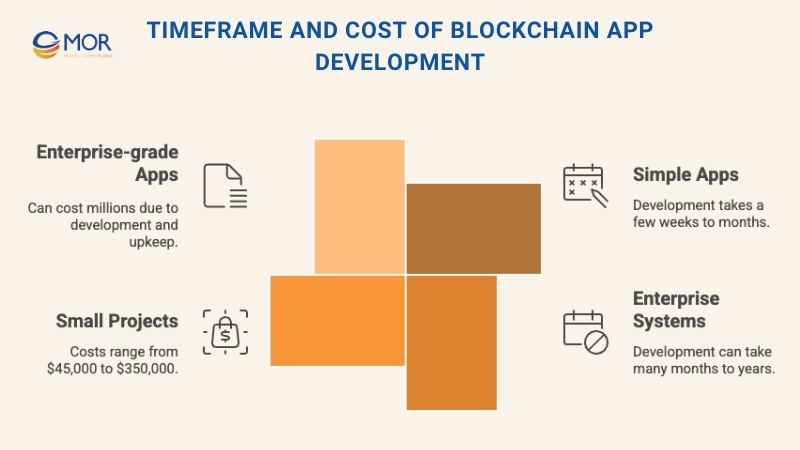
The bulk of the effort lies in the coding phase, where the team builds smart contracts, integrates blockchain layers, and develops core functions. A small app may take two to three months, while complex solutions often exceed a year.
Testing extends the timeline further. It involves unit, integration, and user acceptance testing to ensure the application is reliable and secure. Depending on complexity and revisions, testing may last weeks or months. Afterward, deployment sets up the live infrastructure, while ongoing updates and maintenance add to long-term cost.
Budget-wise, simple projects range from $45,000 to $350,000, while large-scale enterprise solutions can cost millions. This includes team expertise, technology stack, third-party tools, and continuous upkeep. Careful planning with the right team ensures both time and cost are managed effectively.
Why Work With MOR Software For Blockchain App Development?
Partnering with a specialized provider makes the difference between a stalled project and a scalable product. At MOR Software, we bring years of experience delivering blockchain software development for finance, healthcare, logistics, and enterprise systems.
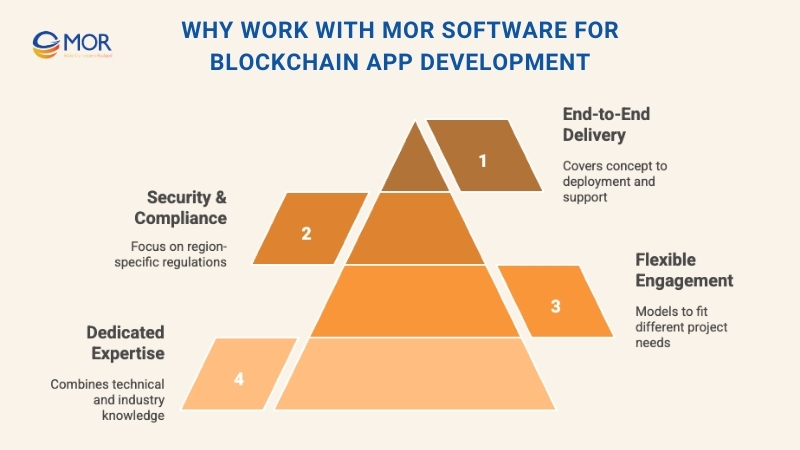
- Dedicated expertise: Our teams combine blockchain knowledge with real-world industry experience to build applications that fit business needs, not just technical trends.
- Flexible engagement models: Whether you need a full-cycle development partner or a dedicated blockchain team, we adapt to your project size and scope.
- Focus on security and compliance: We design blockchain applications with advanced security practices and ensure alignment with regional regulations.
- End-to-end delivery: From concept and UI/UX to deployment and support, we provide a complete development cycle that reduces risks and accelerates go-to-market.
By working with MOR Software, you gain a trusted technology partner who can turn complex blockchain concepts into business-ready applications. Contact us right now.
Challenges In Blockchain App Development & How To Overcome Them
Distributed ledger technology opens new opportunities, but blockchain app development is not without hurdles. Tackling these challenges early is vital to deliver secure, scalable, and user-focused solutions.
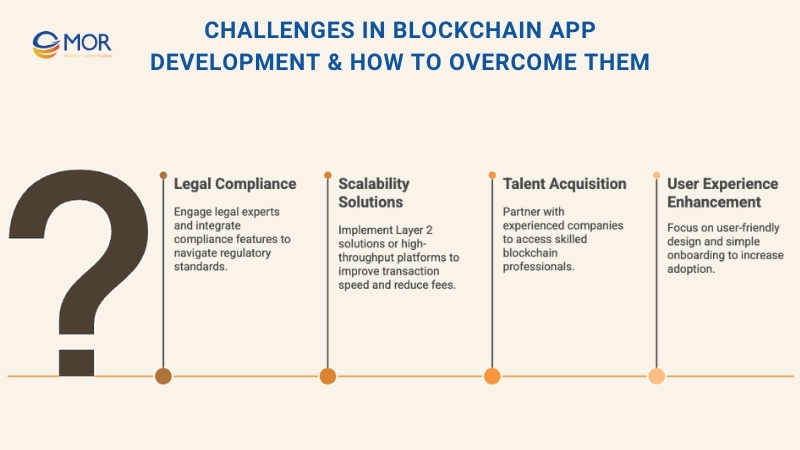
Complex Legal And Regulatory Standards
Rules around blockchain apps differ across countries, from how digital assets are classified to how data privacy laws apply. This patchwork creates uncertainty for businesses looking to scale globally.
Solution
The best approach is to work with legal experts and a trusted blockchain development company in USA or other key markets that understand local regulations. Building compliance features, like flexible identity management and audit trails, directly into the app helps reduce risks. Keeping pace with guidelines such as SEC rulings in the US or MiCA in the EU ensures your project remains legally sound.
Scalability Concerns
As more users join, blockchains often struggle with slower processing speeds and higher fees, especially on networks like Ethereum.
Solution
To address this, consider Layer 2 options such as Optimism or Arbitrum, sidechains, or platforms like Solana that are built for high throughput. Offloading non-critical data off-chain also helps. The right architectural decisions in blockchain app development will shape scalability for years to come.
Talent Shortages In Blockchain Skills
Developing blockchain apps requires knowledge of cryptography, Solidity, and decentralized architecture. Skilled developers are still relatively scarce, making it tough for businesses to hire.
Solution
The best move is to partner with an experienced blockchain app development company that provides dedicated professionals. With the right expertise, projects are more likely to stay on budget and meet expectations.
User Experience Barriers
Even as blockchain grows, many decentralized apps face low adoption due to clunky UX, confusing onboarding, and heavy technical terms.
Solution
Prioritize user-first design. Vendors delivering blockchain app development services should include simple onboarding, clear in-app guides, social logins, and fiat-to-crypto payment options. This makes the technology more approachable for mainstream users.
Conclusion
Blockchain app development has moved beyond experimentation into a proven way for businesses to boost security, improve efficiency, and unlock new revenue streams. Success, however, requires the right strategy, tools, and expertise. MOR Software delivers end-to-end blockchain app development services, helping businesses move from concept to launch with confidence. Ready to turn your idea into a scalable solution? Contact us today.
MOR SOFTWARE
Frequently Asked Questions (FAQs)
What is a blockchain app?
A blockchain app, or dApp, runs on a distributed ledger instead of a single central server. Transactions and data are recorded in linked blocks across many nodes, which makes the system more transparent and less vulnerable to a single point of failure.
Can we build a blockchain app without cryptocurrency?
Yes. You can build permissioned or tokenless blockchain solutions where no public cryptocurrency is required. Tokens are useful for incentives and public networks, but many enterprise use cases run fine without coins.
How much does it cost to build a blockchain app?
Costs vary by scope and complexity. Typical ranges are roughly: basic apps $20,000 to $40,000, mid-level $40,000 to $100,000, enterprise $100,000 to $300,000 or more. Key cost drivers include integration needs, security and audit work, team location, and length of testing and deployment.
What is blockchain in software development?
Blockchain is a distributed database that groups records into cryptographically linked blocks, producing an append-only ledger shared across participants. Developers use it when they need verifiable, tamper-resistant records and a decentralized source of truth.
What is the difference between blockchain and crypto app?
A crypto app centers on tokens, wallets, and financial transfers. A blockchain app uses the ledger and smart contracts for broader problems like supply chain, identity, or records management. In other words, crypto apps are a subset of blockchain apps.
How do I program my own blockchain?
Decide the consensus mechanism and node architecture, implement block and transaction structures, build networking and peer discovery, add validation and state management, expose APIs, and run extensive security and performance tests. Using existing frameworks speeds development.
Does blockchain require AI?
No, blockchain and AI are separate technologies. They complement each other though, because blockchain can provide trustworthy data for AI, and AI can add analytics, anomaly detection, and smarter automation on top of blockchain data.
How much does a blockchain developer cost?
Costs depend on region, experience, and required skills. Fixed-price projects might range from $15,000 to $100,000 plus, while hourly rates often vary roughly from $30 to $150 or more, depending on seniority and specialization.
What is the salary of a blockchain developer?
Salaries vary widely by country and experience, for example entry to mid-level ranges differ across markets. For current, local figures check job sites and salary surveys for your region, since compensation changes quickly.
Rate this article
0
over 5.0 based on 0 reviews
Your rating on this news:
Name
*Email
*Write your comment
*Send your comment
1